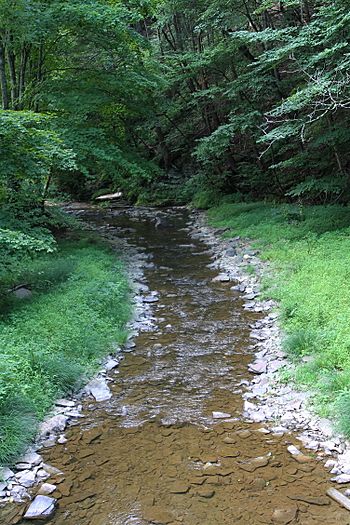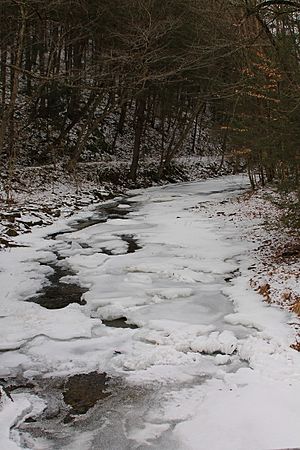West Branch Run facts for kids
Quick facts for kids West Branch Run |
|
|---|---|

West Branch Run looking downstream
|
|
| Other name(s) | West Branch Little Fishing Creek |
| Physical characteristics | |
| Main source | Jordan Township, Lycoming County, Pennsylvania approximately 1,260 feet (380 m) |
| River mouth | Little Fishing Creek in Pine Township, Columbia County, Pennsylvania 679 ft (207 m) 41°08′48″N 76°31′38″W / 41.14665°N 76.52723°W |
| Length | 7.3 mi (11.7 km) |
| Basin features | |
| Progression | Little Fishing Creek → Fishing Creek → Susquehanna River → Chesapeake Bay |
| Basin size | 10.20 sq mi (26.4 km2) |
| Tributaries |
|
West Branch Run is a cool stream in Pennsylvania, USA. It flows through parts of Lycoming County and Columbia County. This stream is also sometimes called West Branch Little Fishing Creek. It's about 7.3 miles (11.7 km) long and eventually flows into Little Fishing Creek. The land area that drains into West Branch Run, called its watershed, is about 10.20 square miles (26.4 km2).
West Branch Run has only one named smaller stream that flows into it, called Shingle Run. The stream also flows through a special valley known as California Hollow. This valley is considered a "locally significant site" because of its natural importance. You can also find the historic Shoemaker Covered Bridge crossing over West Branch Run.
Contents
Journey of West Branch Run
West Branch Run starts its journey in Jordan Township, Lycoming County. It flows southwest for over a mile before turning south-southwest. After flowing a bit more, it leaves Jordan Township and enters Pine Township.
In Pine Township, the stream turns southwest for a short distance. Then, near a place called Pine Summit, it turns southeast. West Branch Run then flows through a rather narrow valley known as California Hollow. At the end of this valley, it meets Shingle Run, its only named tributary. After this, the stream suddenly turns south.
After flowing for more than a mile, West Branch Run passes under the famous Shoemaker Covered Bridge. It also crosses Pennsylvania Route 442 along the way. The stream then turns southeast, crosses Pennsylvania Route 442 again, and soon after, it joins Little Fishing Creek. West Branch Run meets Little Fishing Creek about 11.16 miles (17.96 km) before Little Fishing Creek reaches its own end.
Shingle Run: West Branch Run's Tributary
The only named stream that flows into West Branch Run is Shingle Run. Shingle Run joins West Branch Run about 1.82 miles (2.93 km) upstream from where West Branch Run meets Little Fishing Creek. The area of land that drains into Shingle Run is about 1.63 square miles (4.2 km2).
Stream Features and Surroundings
The elevation of West Branch Run near where it joins Little Fishing Creek is about 679 feet (207 m) above sea level. Where the stream begins, its elevation is much higher, around 1,260 feet (380 m) above sea level.
West Branch Run flows through a special valley called California Hollow in Pine Township, Columbia County. This stream has high levels of dissolved oxygen, which is good for the aquatic life living in it.
West Branch Run's Watershed
The total area of land that collects water for West Branch Run, known as its watershed, is about 10.20 square miles (26.4 km2). One interesting fact about West Branch Run is that there are no roads built along it where it flows through California Hollow. This is quite rare for streams in Columbia County.
Bridges Over the Stream
The Shoemaker Covered Bridge is a historic bridge built over West Branch Run in 1884. It was constructed by T.S. Christian and is 49 feet (15 m) long. This beautiful bridge was repaired in 2008 to keep it safe and strong. Another bridge, carrying the road T-720, was built over the stream in 1936. It is 26.9 feet (8.2 m) long.
Wildlife and Plants Around West Branch Run
The California Hollow area, where West Branch Run flows, is very important for nature. It is listed as a "locally significant site" on the Columbia County Natural Areas Inventory.
Plants in California Hollow
The slopes of California Hollow are home to trees like hemlock and white pine. Experts believe that this area might have a wide variety of native plants. This means many different types of plants that naturally grow there. It also has very few invasive plants, which are plants that can harm the local ecosystem.
Animal Life and Reproduction
West Branch Run is a great place for trout. These fish naturally reproduce in the stream, meaning they lay their eggs and new trout hatch there on their own.
Images for kids



